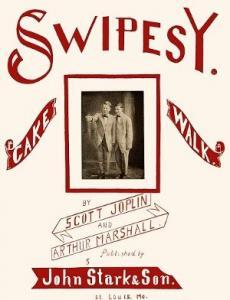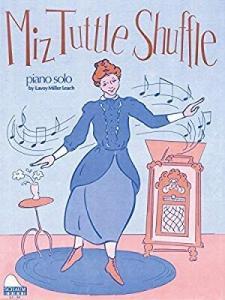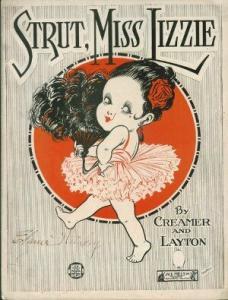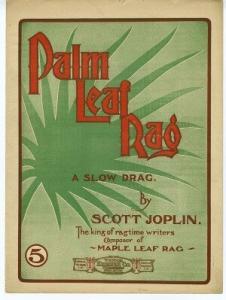A Stomp by any other name would sound as sweet!
I have wondered why certain song titles include the following descriptions: Stomp, Breakdown, Boogie, Ramble, Jump, Jubilee, Shuffle, Cakewalk, Swing, Strut, etc. Of course, a whole genre of music refers to Blues, but traditional jazz also has a lot of what were popular dance steps contained in the titles.
New Orleans Jazz began in the early 1910s combining brass band marches, French quadrilles, beguine, ragtime, and blues with a collective polyphonic improvisation and an added element from Cuban/Spanish cultures. Its many characteristics include both syncopation and swing rhythms; a walking bass (a rising/falling sequence of notes); glissandi (finger slides from one note to another) and instrumental breaks.
At the most recent 50th Jazz & Heritage Festival, Lars Edegran’s New Orleans Ragtime Orchestra performed a stomp and drummer Benny Amon, literally (and loudly!) stomped his right foot on the wooden floor at a  particular moment. Had there been dancers also performing, you would have seen them stop their glide across the floor and “stomp” at the appropriate pause. So, many of the song titles indicated a particular style of dance or musical passage.
particular moment. Had there been dancers also performing, you would have seen them stop their glide across the floor and “stomp” at the appropriate pause. So, many of the song titles indicated a particular style of dance or musical passage.
Browsing through a dictionary of musical terms reveals the intended messages that the writers and lyricists wanted to express to the listeners. In some tunes the dance name is in the song title but the tune is performed in a different style. It probably sounded better to the lyricist and provided an alliterative or poetic title.
Let’s start with “Syncopation”—a variety of rhythms which are in some way unexpected, making part or all of a tune or piece of music “off beat.” It is a disturbance and an interruption of the regular flow of rhythm. That is a great definition of our whole concept of traditional jazz and of the era we admire.
Stomp – a tune or song with a fast tempo and a heavy beat. It is a lively dance and we know that both the musicians and dancers actually stomped their feet during the performance: Stompin’ at the Savoy; Steamboat Stomp; King Porter Stomp; Mahogany Hall Stomp; Red Hot Pepper Stomp; Black Bottom Stomp.
 Breakdown – part of a song in which various instruments have solo parts or breaks. This may take the form where all instruments play the verse together and then several or all instruments individually repeat the verse as solo parts. It can also be a passage when all the instruments stop for a few beats and a solo instrument fills the gap with a flourish. Usually the bridge or middle part of the song differs from the pattern of the verse and chorus: St. Philip St. Breakdown; Foggy Mountain Breakdown; New Orleans “Yea, Yea” Breakdown.
Breakdown – part of a song in which various instruments have solo parts or breaks. This may take the form where all instruments play the verse together and then several or all instruments individually repeat the verse as solo parts. It can also be a passage when all the instruments stop for a few beats and a solo instrument fills the gap with a flourish. Usually the bridge or middle part of the song differs from the pattern of the verse and chorus: St. Philip St. Breakdown; Foggy Mountain Breakdown; New Orleans “Yea, Yea” Breakdown.
Shuffle – a series of triplet notes with the middle note missing so that it sounds like a long note followed by a short note: Dixie Land Shuffle; New Orleans Shuffle; Showboat Shuffle; Friar’s Point Shuffle; Kansas City Shuffle; Riverboat Shuffle; St. Louis Shuffle. Although a few of these may not be true to the style, there are dozens of “city-named” Shuffles.
Cakewalk – dance based on a march with intricate steps. The dancers were awarded cakes as prizes in dance contests: Swipsey Cakewalk; Cakewalking Babies From Home.
Swing – the beat is divided into two parts, the first beat is exactly twice the duration of the second beat. It is related to the concept of unequal duration of beats: Washington & Lee Swing; Georgia Swing; Satchelmouth Swing; and of course, It Don’t Mean A Thing If It Ain’t Got That Swing.
 Strut – is a dance with a brisk and self-assured walking rhythm. The head is held high and the swagger confirms a proud and pompous step: Oriental Strut; Jambalaya Strut; Bogalusa Strut.
Strut – is a dance with a brisk and self-assured walking rhythm. The head is held high and the swagger confirms a proud and pompous step: Oriental Strut; Jambalaya Strut; Bogalusa Strut.
Ramble – generally to aimlessly wander about, just ambling along, a happy sense of lack of structure. In many Blues songs, the meaning had more to do with infidelity and promiscuity: Tailgate Ramble; Muskrat Ramble (again not technically a Ramble but one of the more popular and requested tunes); Didn’t He Ramble.
Jump – an up-tempo style, it is a difference in pitch between two consecutive notes greater than a whole or half step: One O’Clock Jump; Jump, Jive & Wail.
Boogie (Woogie) – also an up-tempo style originally associated with the piano. As the right hand plays the melody with variations in the treble, the left hand repeats a melodic pattern in the bass with the distinctive eight beats to the bar: Rampart St. Boogie; Pine Top Boogie Woogie; Basie Boogie; Cow Cow Boogie.
Rag – is primarily a solo piano style that was the immediate precursor to jazz from 1895 to 1919. The right hand plays syncopated melodies in a “ragged” fashion with a steady accompaniment in the left hand: Tiger Rag; Red Rose Rag; Black Stick Rag.
 Joys and Jubilees – were celebrations: Milneburg Joys; Jubilee!
Joys and Jubilees – were celebrations: Milneburg Joys; Jubilee!
Wiggle – this is somewhat self-explanatory: New Orleans Wiggle; Angel Worm Wiggle.
Drag – a dance in a slow tempo originated in the late 19th century and one of the earliest known blues partner dances. Dancers would drag their feet across the floor emphasizing the offbeat. Their feet would remain flat against the floor to avoid restrictions at the time against what was considered more vigorous dancing while crossing one’s feet. Danny Barker (revered multi-instrumentalist and New Orleans icon) would describe it as “belly rubbing music”: Slow Drag; Sunflower Slow Drag; Varsity Drag (although more of a Charleston than a Drag).
Shimmy – a dance move in which the body is held still, except for the shoulders, which are quickly alternated back and forth. When the right shoulder goes back, the left one comes forward: Shimmy Sha Wabble; I Wish I Could Shimmy Like My Sister Kate.
As Fred Starr, leader of the Louisiana Repertory Jazz Ensemble, often mentions this was dance music and many titles reflect that origin and purpose. So next time you hear a Stomp or a Shimmy— well, you know what to do!
After 48-1/2 years, Shelly Gallichio is a retired Real Estate Associate Broker in Tucson, Arizona and despite growing up in Chicago, fell in love with the clarinet and the New Orleans sound at the age of three—she intends to spend the next 48-1/2 years seeking that sound! Reach her at shellygallichio44@gmail.com






















